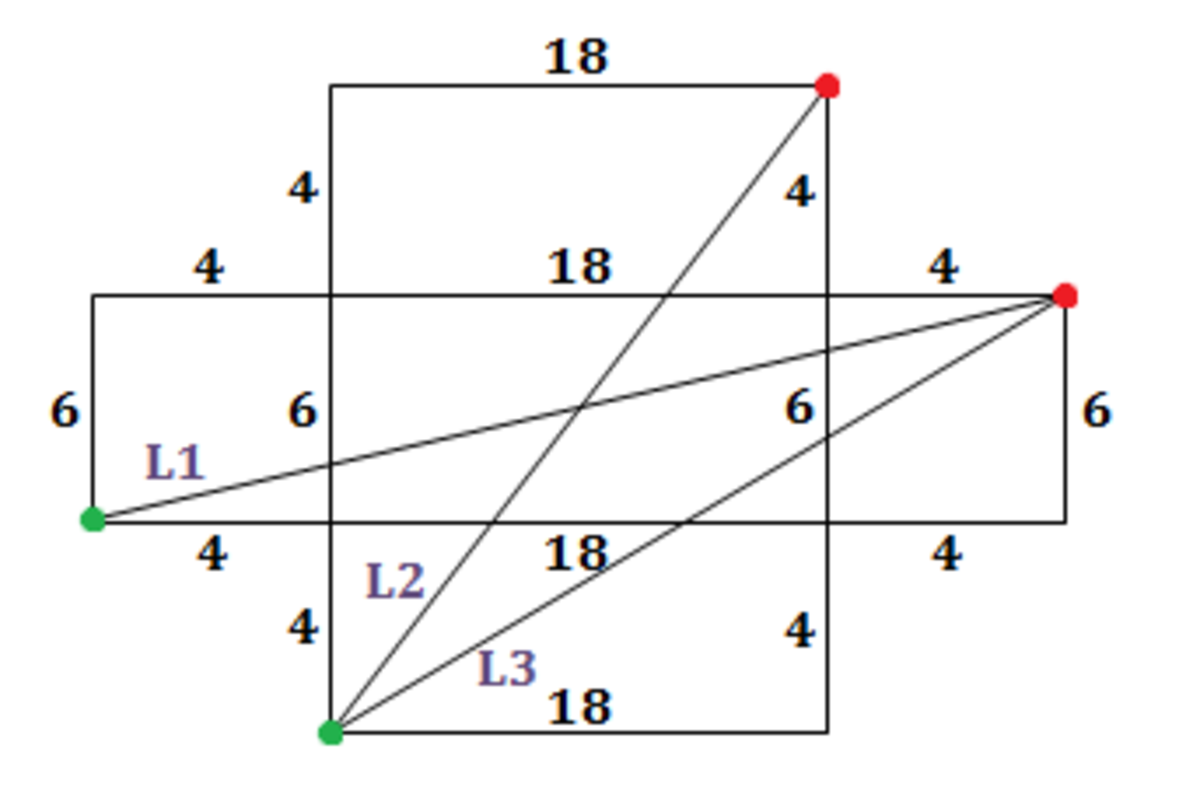An Ant's Journey
There is a 4 × 6 × 1 8 inch cereal box lying on the floor. It was placed face down on one of its 6 × 1 8 inch face. An ant is located at one of the bottom corners of the box. It wants to reach the opposite bottom corner (of the 6 × 1 8 face on the floor), by crawling along the outside of the box, or on the floor. The length of the shortest such path is R inches. What is the value of R 2 ?
Details and assumptions
The ant may not crawl under the box.
The answer is 520.
This section requires Javascript.
You are seeing this because something didn't load right. We suggest you, (a) try
refreshing the page, (b) enabling javascript if it is disabled on your browser and,
finally, (c)
loading the
non-javascript version of this page
. We're sorry about the hassle.
7 solutions
All solutions proceeded by unfolding the cube. This solution is the best in terms of presenting the different cases. All other solutions left out a case or two.
However, all solutions were marked wrong. Why? Hint: Most of the wrong numerical answers submitted was 576.
Thorough treatment! Just adding the figure showing the three paths
 Imgur
Imgur
If the ant crawls only along the floor around the box, it will travel 6 + 1 8 = 2 4 inches.

If the ant crawls on the box, consider the flattened version of the box (refer to the image above). The shortest distance would be a straight line across the rectangle. The ant can crawl along the diagonal of a 6 × 2 6 rectangle (L1), or a 1 4 × 1 8 rectangle (L2), or a 1 0 × 2 2 rectangle (L3). We use the Pythagorean theorem and find that the 1 4 × 1 8 rectangle has the shortest diagonal length, which is 5 2 0 . Since 5 2 0 < 5 7 6 = 2 4 2 , this will be the shortest length. Thus, R 2 = 5 2 0 .
Let's open the box carton...Since the ant may not crawl under the box,neglect the undersurface..Note that straight line distance between any 2 points is the shortest possible.The ant's journey,as in the diagram, starts from A or B & ends in C or D. (In 3D box, A & B coincide at starting corner,and C & D coincide at opposite bottom corner.) So,however it crawls,it must follow paths AC,AD,BC or BD for shortest straightway paths.Applying Pythagoras' Theorem,observe that A C 2 = ( 1 8 + 4 ) 2 + ( 6 + 4 ) 2 ; A D 2 = ( 1 8 + 4 × 2 ) 2 + 6 2 ; B C 2 = ( 6 + 4 × 2 ) 2 + 1 8 2 & finally B D 2 = ( 1 8 + 4 ) 2 + ( 6 + 4 ) 2 . Thus, B C 2 = 5 2 0 is shortest..
R = ( 4 + 6 + 4 ) 2 + 1 8 2
Two pairs of vertical faces are (6x4) and (18x4) - there are 3 cases a) open both 6x4 faces level with the top face 6x18, obtain a rectangle 6x30 b) open one 18x4 and one 6x4 face level with top face and consider hypotenuse of right angle triangle with perpendicular sides 10 and 22 c) open both 18x4 faces level with top face, obtain a rectangle 14x18 Case c) gives shortest path with R^2 = 14^2 + 18^2 = 520
We can fold the box out to make a "net" without the bottom face.
It is easy to see that the shortest path is either going over the 4 by 6, the top 6 by 18, and then on the second 4 by 6 face to the end point, or starting on the 4 by 18 face, going on the top of the 6 by 18, and then on the second 4 by 18 face.
These shortest paths are obviously lines, so we can use the pythagorean theorem to get that the two possible lengths are 5 2 0 or 7 1 2 .
Thus, 5 2 0 is the shorter value of R, so R^2 is equal to 520
To find the shortest distance the ant must travel to reach the opposite bottom corner, we unfold the box. There are 3 ways to unfold the box: pulling out two 4 × 6 faces, pulling out a 4 × 6 face and a 4 × 1 8 face, or pulling out two 4 × 1 8 faces.
If we unfold the two 4 × 6 faces, the distance the ant travels is the length of the hypotenuse of a right triangle with side lengths 6 and 2 6 , which is 6 2 + 2 6 2 = 7 1 2 .
If we unfold the 4 × 6 face and the 4 × 1 8 face, the distance the ant travels is the length of the hypotenuse of a right triangle with side lengths 1 0 and 2 2 , which is 1 0 2 + 2 2 2 = 5 8 4 .
If we unfold the two 4 × 1 8 faces, the distance the ant travels is the length of the hypotenuse of a right triangle with side lengths 1 4 and 1 8 , which is 1 4 2 + 1 8 2 = 5 2 0 .
Thus, the shortest path for the ant is by unfolding the two 4 × 1 8 faces, and R 2 is 5 2 0 .